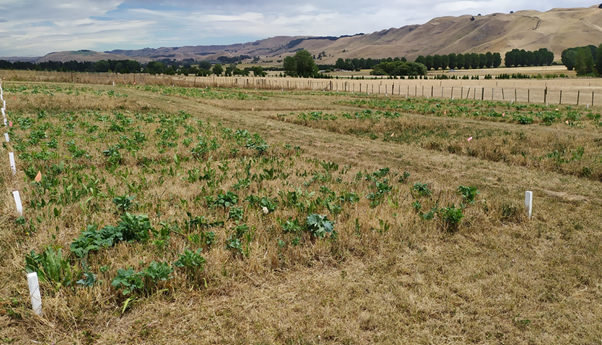Diverse pastures put to the test
Take one expert team of animal and plant scientists. Add a long-running research farm in dryland Hawke’s Bay. Combine with more forage species than you’ve ever imagined, and simmer carefully on 4.5 years of private and public funding.
What do you get?
In this case, the first replicated field experiment of its type in New Zealand, measuring exactly what happens – to the pasture, and the soils below it – when you sow four, six, seven, 11 or 31 different plants in one mix.
Curious? We were too, which is why we got involved. Three years down the track, one thing seems clear. Sowing large numbers of seed types does not achieve pasture diversity.

A bird’s eye view of the trial area.
The big picture
Welcome to the resilient agriculture project at Poukawa Research Farm. There’s a lot going on here, driven by an MPI Sustainable Farming Fund grant that began May 2021.
Other funders include Hawkes Bay Regional Council, AGMARDT, Ravensdown, Atkins Ranch, Poukawa Research Foundation and Barenbrug.
Since then, Drs Paul Muir, Beverley Thomson and staff at On-Farm Research have been tasked with scientifically evaluating principles of regenerative agriculture.
As well as evaluating non-synthetic fertility regimes, they are recording soil carbon, animal production, soil microbial activity, water infiltration rates, worm numbers, visual soil assessments and greenhouse gases across three different farmlets grazed by a range of animals.
They also sowed a replicated mowing trial investigating the effect of species composition and mowing height on dry matter production, persistence, feed quality and soil characteristics for five different pasture mixes.

Soil carbon is one of several measurements being recorded by Poukawa researchers.
The details
Two of the five mixes studied came from us - the Barenbrug herb mix (six species, sown at 25 kg/ha), and our diverse mix (11 species, 20 kg/ha).
The other combinations sown in the trial were two already used on the farm – ryegrass/clover (four species, 32 kg/ha) and plantain/clover (seven species, 22 kg/ha); plus a 31 species mix obtained locally online.
This was sown at the recommended rate of 180 kg/ha, plus three other rates (45, 90 and 135 kg/ha).
Sixty-four plots were established in May 2021, comprising eight different treatments. Animals were excluded; preferential grazing would have compromised the results, so mowing was the only way to achieve scientific rigour.

Trial plots in early February 2022.
Measuring up
Two mowing heights were tested – 8 cm and 20 cm. The trial lasted two years; 11 cuts were taken.
Throughout the trial, the team assessed species and proportions. They measured pasture Brix and metabolisable energy levels across all treatments four times, and soil water infiltration three times.
They buried pieces of cotton to test microbial activity in four of the eight treatments at both mowing heights during the trial, and counted species and numbers of earthworms in all plots at the end.
Soil carbon, nitrogen and bulk density samples were taken before the trial began, and again at the end.

Brassicas and cereals dominated initial dry matter yield for the RA mix, but disappeared by the end of the trial.
Cut to the chase
Over two years, pastures cut at 8 cm yielded much more than those cut at 20 cm, averaging 26,190 kg dry matter/ha compared with 16,850 kg.
The scientists say this 55% difference was partly because of the unharvested material between 8 cm and 20 cm, but also because plants respond differently to mowing (or grazing) height.
Plantain/clover cut at 8 cm produced the most over two years; ryegrass/clover cut at 20 cm grew the least.
There was no significant yield difference between the four different sowing rates of the 31-species diverse mix cut at 20 cm, nor in the two sowing rates cut at 8 cm (180 kg and 45 kg seed/ha).
Initially, the diverse mix tended to out yield the others, with annual ryegrass, cereal and brassica seed contributing an extra 1500 kg dry matter/ha in the first winter. But once these died, cocksfoot dominated the diverse mix.

Earthworms were counted in all plots at the end of the study.
Let’s dissect
Of the 31 species sown in the diverse mix, six were never seen (lotus, maize, canary grass, squash, buckwheat and sunflower).
At the end of trial, only seven species remained.
In the remaining four mixes, most sown species still tended to be present at the end of the trial, barring annual clovers.
Plantain remained a significant species, particularly in the plantain/clover sward. When sown, cocksfoot tended to dominate at the end of the trial, and this dominance led the team to terminate the trial.
Dead matter was high in all swards mown at 20 cm when the trial finished (20-30%), because of the high cutting levels.
Going underground
Sowing mix and mowing height had no effect on earthworm numbers, microbial activity, water infiltration rates, or soil carbon.
There have been suggestions that diverse mixtures would improve soil health but there was no evidence of this happening over the time frame of this study, the scientists say.
They’ve now started another pasture trial comparing diverse pasture and ryegrass pasture using cutting heights of 5, 10 and 15 cm and at different mowing frequency (4 and 8 weeks).
In this trial, the diverse mixture has 18 species, but missing are the cereals and brassicas and cocksfoot.
We remain involved in the project, and continue to follow the team’s work with great interest.
If you’d like to talk about any of your pastures – diverse or otherwise – we’re always happy to hear from you. Book your free Pasture Health Check today.


